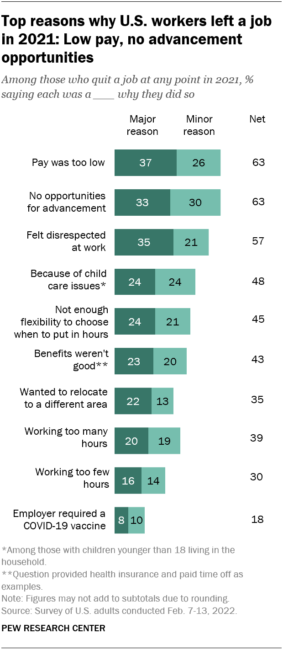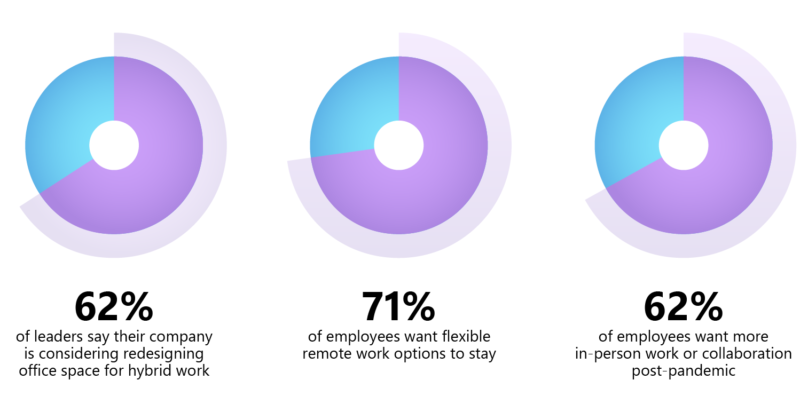
Contents
- Why employers need to know their drivers of employee engagement
- Do workers feel less engaged today?
- What are the key drivers of employee engagement?
Staff happiness has long been touted as the main factor behind productivity and business success. But what many business owners and managers struggle with is understanding what it is that makes workers happy. We look at a few examples of key drivers of employee engagement that you can leverage when leading your hybrid teams.
The past two years have been a major shock to the system for workplaces around the world. The unprecedented disruption created seismic changes in work arrangements, leaving lasting effects on organisations.
For instance, our research on employee attitudes shows that 55% of UK and US employees now want a mix of office and home-based work (i.e., hybrid working), while another 9% want to work in a combination of home, office, and approved public spaces.
Download: The Hybrid Workplace: An Employee Census Report
This introduces a new challenge for employers and managers who want to maintain a cohesive work culture that supports communication and collaboration. Keeping employees engaged is difficult enough when they’re all in the same place. The growing permanence of hybrid working models adds another layer to this challenge, calling into question established drivers of employee engagement.
Why employers need to know their drivers of employee engagement
As the adage goes, happy employees are productive employees. In one Oxford study, researchers found that employees are 13% more productive when they’re happy.
But this begs the question: What exactly makes employees happy, or, at the very least, satisfied at work?
While different people have different sources of motivation and satisfaction, a factor that often comes up is employee engagement: the emotional commitment workers have to the company and its goals.
When employees are engaged, they’re more likely to be more invested in their work. In fact, companies with an engaged workforce have double the success rate of organisations with less engaged workers.
Related Reading: How to Build Employee Engagement, Satisfaction, and Increase Staff Retention
Do workers feel less engaged today?
Short answer? Yes. Long answer? It depends on where you look.
For instance, a recent Gallup Workplace report shows that employee engagement fell for two consecutive years in 2022. After trending upwards throughout the last decade, US employee engagement levels dropped to 32% this year, down from 36% in 2020 and 34% in 2021. Meanwhile, 17% of US workers feel actively disengaged — up one percentage point from last year.
Source: Gallup
While these findings paint a grim picture of current employee attitudes, Gallup notes that some employers have more than doubled this percentage. These successful companies, or Gallup Exceptional Workplace Award (GEWA) winners, “continued to engage and develop their people” and achieved their desired business outcomes even during a turbulent period.
This brings us to the exciting part of this guide: What drivers of employee engagement did these companies use to satisfy their workforce?
What are the key drivers of employee engagement?
1. An authentic, people-centric corporate culture and values
Gallup found that GEWA winners habitually put their people — customers and employees alike — at the heart of their values and decisions. But what separates these companies from those that say “we’re here for you” is that they listened to their workers and acted based on their needs.
Related Reading: How to Enhance Workplace Culture in a Post-Covid Hybrid Environment
When people see their feedback turn into action, they know that the organisation isn’t just paying lip service to its “values.” This establishes trust between employees and leadership, arguably the secret sauce of employee engagement.
Cloudbooking Tip: Employee engagement surveys are a tried and proven method for obtaining insights into drivers of employee engagement in your company. There are generally two methods of initiating employer engagement surveys:
- In-house or initiated by the employer
- Through a third-party survey company.
In-house surveys are quick and easy to deploy. However, third-party survey companies can ensure the impartiality and anonymity of surveys, helping acquire more insightful survey results. Whatever the case, your survey should, at the very least, tackle these issues:
- Organisational commitment
- Job satisfaction
- Commonly encountered problems.
2. Adopting flexible working arrangements and preparing for the future of work
Nearly all of Gallup’s winning organisations embraced flexible working arrangements in some way or the other. Among companies with traditional office-based workplaces, the shift to remote and/or hybrid work was a key priority in 2021. Some organisations also took the time to train their managers on how to work remotely and lead hybrid teams effectively.
In other words, if you’ve already transitioned to a hybrid working model, you’re already one step closer to building an engaged workforce.
Related Reading: Flexible Working: The Key to Health and Well-Being?
Cloudbooking Tip: Equally crucial to allowing workers to work in a hybrid environment is ensuring your office spaces and facilities are designed for hybrid working. Research by Microsoft shows that 62% of companies are planning a redesign of their office spaces for hybrid work.
Source: Microsoft
Companies have an opportunity to create workspaces that accommodate dynamic work schedules — allowing workers to come and go to the office without having to worry if there’s a workstation or room for them. Desk and room booking software, for example, provide employees with real-time views of your office floor plan, allowing them to choose where to work and schedule collaborative sessions in huddle rooms with other team members.
Cloudbooking’s Workspace Booking Platform
3. Paying attention to employee well-being and the individual
Concerns about work-life balance, mental health, and burnout at work are just a few of the many drivers of the “great resignation” — a trend of workers quitting their jobs and collectively saying, “We deserve better.”
Related Reading: The Great Resignation: New Employee Expectations Post-Covid
Unsurprisingly, companies with high levels of employee engagement excel at addressing these same issues. Gallup found that a distinguishing practice of GEWA winners was a clear and concerted effort to prioritise their employees’ well-being. Many took steps to remove the stigma associated with poor mental health at work. Others spent time understanding their employees’ needs in the context of age, gender, ethnicity, and sexual orientation.
These measures enabled companies to understand their employees’ needs and support the symbiotic relationship between well-being and engagement.
Cloudbooking Tip: While insufficient pay is the leading reason people left their jobs in 2021, disgruntled workers also cited a lack of career progression as a factor for their dissatisfaction, according to data from Pew Research Center.

Consider tracking the number of promoted employees in your organisation over the last one to five years. Be sure to look at lateral moves; the freedom to move across departments, business units, and teams can also be a critical driver of satisfaction in the workplace.
Discover more insights about employee management by following the Cloudbooking blog. If you need a cloud-based solution to enable flexible and hybrid working in your workplace, get in touch with the Cloudbooking team. Our workplace management platform helps employees navigate their new office environment with user-friendly room and booking solutions. Schedule an obligation-free demo to learn more.





